How to change a light bulb correctly: analysis of the technical nuances of a non-trivial task
It would seem that the answer to the question of how to change a light bulb has been known to almost all people since childhood.But for some reason, accidents regularly occur while performing such actions.
This indicates that the preparation of citizens is far from ideal, and in a number of situations they do not have any special skills or concepts about the necessary security measures. Which leads to disastrous consequences.
To prevent replacing a light bulb from causing an electric shock, mercury vapor poisoning, or some other unpleasant situation, let's take a look at the specifics of performing this non-trivial task. In this article we will pay special attention to the process of proper replacement, as well as the issue of personal safety and proper disposal of dismantled light bulbs.
The content of the article:
How to replace a light bulb
Proper replacement of a light bulb begins long before its dismantling/installation, since the contractor or owner of the premises must carry out a number of preparatory work in advance. These include the preparation of protective ammunition, tools and equipment.
Ignoring any of the listed points is to your detriment, since efficiency, safety and quality of lighting largely depend on them. They should definitely be taken into account before you plan to replace any light bulb.
Step #1 - preparation for work
When preparing to replace any lamps, be aware of the electrical hazards. Therefore, all work must be performed using special tools, testing instruments and equipment.
That is, pliers, screwdrivers and everything else must have insulation that can protect against damage. Moreover, with its help you can protect yourself from electricity when its voltage is less than 24 Volts, but in other cases it does not guarantee anything.
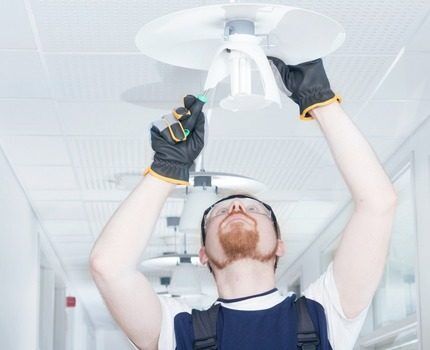
Work should be performed exclusively in protective equipment, which includes rubber gloves and special glasses, which will help protect you when dismantling a hot incandescent lamp, as well as in case of accidental damage luminescent or LED light bulb.
The contractor must have measuring instruments with him that will help verify the functionality of the circuit and lamp and thereby ensure a sufficient level of safety. These include indicator screwdrivers and other similar equipment.
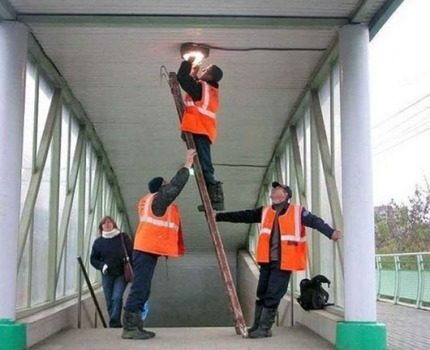
In addition, a person who decides to replace the lamp himself must figure out in advance how to turn off the power in the room and do it correctly. If the issue is not given due time, then the necessary security will not be ensured, and this is fraught with disastrous consequences.
Step #2 - complete blackout
You need to understand that you have to carry out any actions in electrical networks at your own peril and risk - why not call an electrician to replace the lamp? But if there are any consequences, you will have to bear responsibility for them and it may even be criminal. It should be remembered that any such procedure must be carried out in compliance with safety measures.
Guiding documents indicate that only people who have received proper training, have practical skills and have undergone instruction may be allowed to perform such work. True, in everyday life, every consumer who uses electricity for a lighting system faces such a problem.
First of all, the network must be de-energized. Moreover, setting the switch to the off position will not be an sufficient measure. Since it does not guarantee safety at all.
For example, there are many cases where electricians made mistakes and the switch did not open the phase wire. Therefore, current continued to flow to the lamp, which was a surprise to the performer.
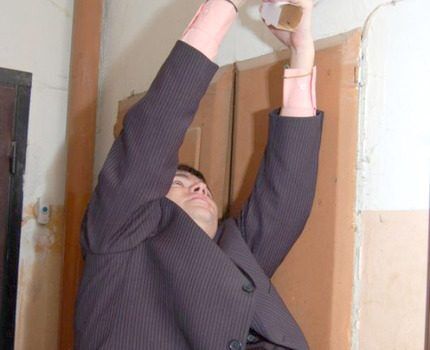
The same thing often happens when switches with backlights that are popular today are used. As a result, only a complete blackout of the room where the replacement will be performed can prevent electrical damage.
To do this, you need to switch the input machine to the off position. Usually they are installed in switchboards, which are located near apartments.If the chain was installed a long time ago, then plugs may be used instead of machines, which means that they need to be unscrewed.
In addition, the contractor is obliged to check the absence of so-called “bugs”. Their danger is that the wires are connected directly, bypassing traffic jams, which can result in electric shock.
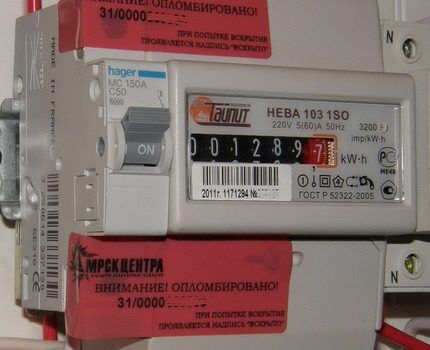
If the lamp receives power from the outlet, then you need to pull out the plug from there. But it should be remembered that residual voltage is also life-threatening. And this phenomenon occurs quite often, so protective measures should be the same as when changing any other lamp.
After the room is de-energized, use an indicator screwdriver to make sure that the desired result is achieved and no current is supplied to the lamp. Only after all of the above operations is it permissible to directly perform the replacement.
But even during this procedure, you should not lean, lean against metal objects, or carry out this procedure in conditions of high humidity.

When the lamp is located at a height, then the performer needs to stock up on a strong stepladder or an extension ladder. With the help of such equipment it is allowed to perform replacement at a height of up to 5 meters.
If it occurs higher, then it is necessary to use special equipment, which are cranes and so on.
In addition, work at a height exceeding 5 m is called high-altitude work and must be performed by specialists with the appropriate clearance.
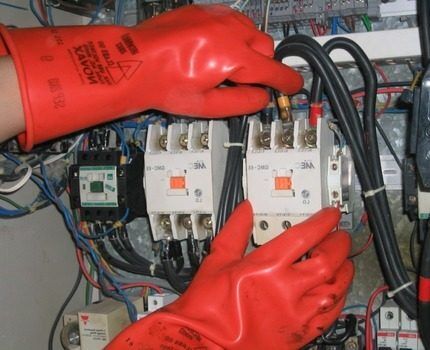
You should not take the listed information about safety measures as frivolous - the same physical education teacher, warehouse worker or any other performer who uses unauthorized equipment and does not have the appropriate skills may be held responsible for the result of their actions and their consequences.
Step #3 - dismantling/installing lamps
To perform this procedure, it is necessary to perform a number of mandatory, but simple actions in a strictly specified sequence. And without using any special tool.
These include:
- Removing lampshades, chandeliers, protective glass, and any decorative elements that impede access to the lamp. All such operations must be performed wearing protective equipment (gloves, goggles).
- Dismantling the lamps is done by twisting movements from right to left. At the same time, you should not grab the hot glass with your hands, which can cause burns. This concerns incandescent lamps. To avoid trouble, you must use a protective glove along with a rubber glove. It will also protect against injury if the glass bulb is damaged.
- Installing a new light bulb is done using screwing movements, that is, from left to right.
- Installation of lampshades, decorative and protective elements.
Regardless of the type of lighting fixture, the replacement procedure is similar and technologically simple.
But when preparing, you should not forget that the glass elements must be wiped with some kind of rag, this will eliminate greasy marks left by your fingers. Since they can lead to premature failure, which occurs as a result of local overheating.
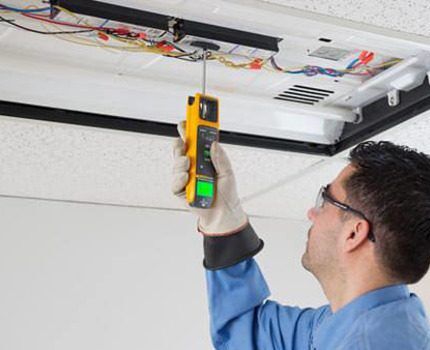
During work, the performer needs to hold the tools only by their insulated parts, which is guaranteed to prevent injury.
Before installing a new lighting fixture, you should find and bend the contact cartridge lamp Since they often do not provide the necessary contact. The same procedure must be performed when the installed lamp does not light. Why should it be dismantled again?
Even if you use glasses when checking the functionality of a newly installed lighting fixture, you should still not be near it. Because explosions often occur that can cause injury.
This primarily applies to incandescent lamps. The reason is that their quality is often quite low, which leads to various unpleasant consequences.
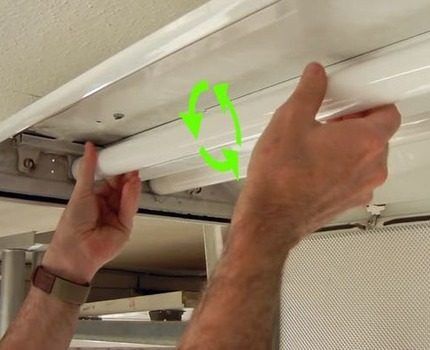
Sometimes the performer is unable to cope with dismantling the lamp. In this case, it must be unscrewed along with part of the cartridge. You should also remember that you should not put pressure on the glass elements, as this will lead to their damage, which can lead to injury.
Subtleties of replacing damaged lamps
It often happens that glass flasks are damaged during dismantling/installation. In such cases, the base itself can be unscrewed using pliers. But before that, you need to collect the scattered fragments.
If such a problem happened to mercury-containing device, then caution should be exercised. Their depressurization can lead to rapid and significant poisoning by vapors, which in a matter of seconds can fill a volume of 50 cubic meters.
And the excess of permissible standards at this moment will be more than impressive - 160 times. Therefore, if damage occurs, the work contractor must immediately evacuate all people in the premises from the premises.
Then carry out ventilation - its duration should be at least 20 minutes. Moreover, these measures are mandatory and the absence of any signs of exposure to mercury vapor should not reassure a person.
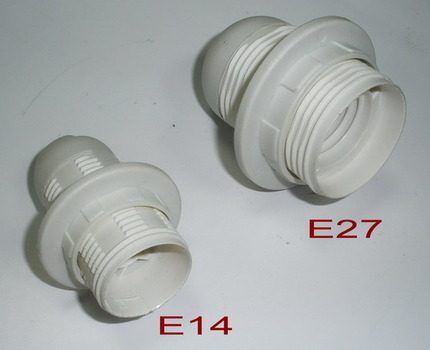
Since they are colorless and odorless, this does not prevent the poison from quickly accumulating in the body, which will lead to poisoning. From which all systems of the body, the organs of vision, without exception, will suffer.
Continue replacing a depressurized mercury-containing lamp only after thorough ventilation and removal of broken glass.
Moreover, to perform it, rubber gloves, goggles, as well as a cotton-gauze bandage, which can be replaced with any damp piece of cloth, must be used.
After eliminating the consequences, you should call the Ministry of Emergency Situations specialists, who will determine whether it is safe for people to stay in the room. They also need to hand over a depressurized mercury-containing lamp.
How to properly dispose of an unwanted lamp?
The dismantled lamp should be handled carefully. That is, it does not need to be placed on hard surfaces, in places where someone’s careless movement will lead to injury.
It is not recommended to throw them in the general trash bag. It is best to get rid of unnecessary lamps immediately. This will help eliminate accidental troubles.

But you should remember that only safe incandescent lamps and their LED analogues are allowed to be simply thrown into a general waste bin. Since they cannot cause any harm other than injuries if handled carelessly.
And mercury-containing products should be handed over to responsible persons, who may be electricians of housing utilities, representatives of structures specializing in recycling, or placed in containers intended for this purpose. The lamp replacement procedure is considered successfully completed only after their disposal.

And only after all of the above can the lamp replacement be considered completed and positive results in terms of safety, comfort and efficiency can be expected.
Conclusions and useful video on the topic
The first video will help you understand the correct procedure when replacing lamps:
The video will help you figure out how to dismantle a damaged glass bulb:
The main point when replacing all kinds of lamps is to comply with numerous safety measures. Which require the performer to have certain knowledge, skills, and use special tools and equipment.
Only all of the above will make it possible to carry out the replacement correctly, that is, safely for the health of the performer and all inhabitants of the house.
Have you repeatedly witnessed accidents due to non-compliance with electrical safety rules that occurred when replacing a light bulb? Tell us about it in the comments section - these stories will help many home craftsmen who are careless about the issue of personal safety to avoid injury and electric shock.




What could be easier than changing a light bulb? But I will tell you what problems I encountered.
Do not rush to unscrew the old lamp immediately after turning off the lamp, it is hot. In the same way, you shouldn’t immediately screw in a lamp brought from the cold.
I've also had problems purchasing a replacement lamp incorrectly. Visually they may be the same, but the base size E14 and E27 are different.
Also, you need to unscrew the lamp using gloves or take a towel. In this case, it is advisable not to direct your gaze to the lamp. Since the bulb may crack, this is unlikely, but still. And the main thing is not to make an effort.If the lamp does not unscrew, it is better to shake it a little or twist it in the other direction.
Before changing a light bulb, be sure to turn off the electricity. The reason a light bulb refuses to turn on is not always due to its burnout. If the chandelier has been hanging for a long time, then the contacts may open or the supply wire may be broken. Of course, it takes time to switch off, but you shouldn’t risk your health. In addition, if you work in the dark, take a flashlight to illuminate the space. Excessive touches can stain them, but in working condition they cannot be wiped clean from hand marks.